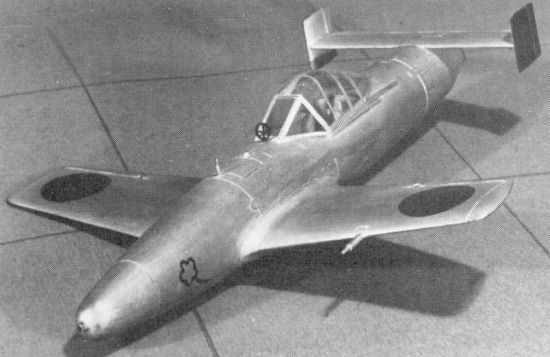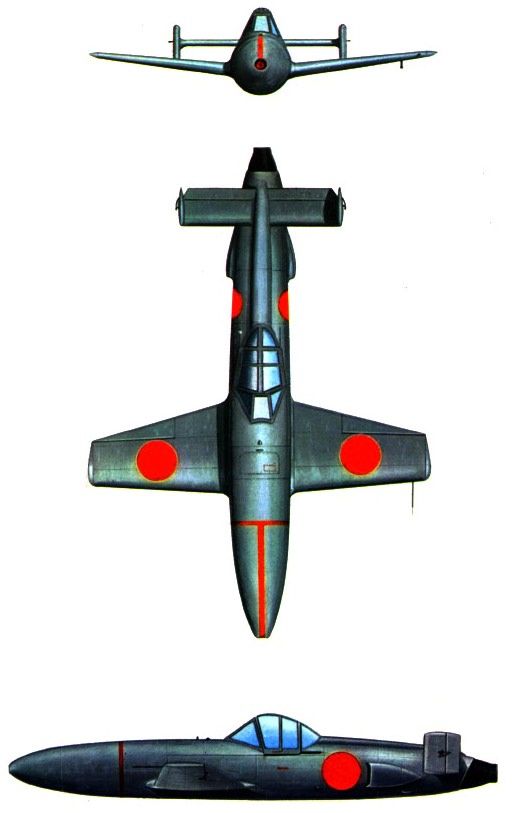|
||||||||||
|
|
||||||||||
|
||||||||||
|
|
||||||||||
 - -
|
|

|
Yokosuka MXY7 Ohka Allied codename: Baka Kamikaze Attack Plane |
|
DESCRIPTION:
As the Japanese military became increasingly desperate to find ways of slowing the Allied advance, naval officer Ensign Mitsuo Ohta conceived a specialized suicide attack aircraft. This plane was to be inexpensive, easy to manufacture in large numbers, and equipped for high speed to avoid being shot down. Once the concept had been accepted, Yokosuka began developing the MXY7 Ohka (cherry blossom). The Ohka was a small, rocket-powered vehicle mounting a large warhead in the nose and intended to be carried to the target area by a Mitsubishi G4M2e bomber. After release, the Ohka would engage its rocket motors to make a high-speed dash to the target ship. Flight testing began in late 1944, but production of the Navy Suicide Attacker Ohka Model 11 began even before these tests were complete. By March 1945, 755 of the Model 11 had been built. Initial deployments, however, proved rather unsuccessful. Although difficult to shoot down because of its high speed, the Ohka was an easy target when still attached to the large, slow mother plane. In addition, the design proved very difficult to maneuver making it nearly impossible to hit even a slow moving target. Attempts to improve the odds of success came in the form of the Model 22 that entered production in 1945. This version featured reduced wingspan and a smaller warhead allowing the Ohka to be carried by the much faster Yokosuka P1Y1 Ginga medium bomber. The Model 22 was also fitted with a Campini-type thermojet engine instead of rockets to increase the Ohka's range as well as reduce speed and improve maneuverability. However, the thermojet was found to be vastly underpowered. Later designs were instead propelled by a turbojet, but none of these reached production before the end of the war. Japan also studied other methods for launching the Ohka, including a land based version and one carried by submarines. Although some 850 Ohkas were built, including trainer versions equipped with landing skids, only 50 ever saw combat. These sank just three enemy ships.
Last modified 17 March 2012
|
|
| HISTORY: | |
| First Flight |
October 1944 [unpowered flight] November 1944 [powered flight] |
|
Service Entry
|
21 March 1945
|
| CREW: |
one: pilot
|
|
ESTIMATED COST:
|
unknown
|
| AIRFOIL SECTIONS: | |
| Wing Root | unknown |
|
Wing Tip
|
unknown
|
| DIMENSIONS: | |
| Length |
(Model 11) 19.90 ft (6.07 m) (Model 22) 22.56 ft (6.88 m) (Model 43B) 26.77 ft (8.17 m) |
| Wingspan |
(Model 11) 16.40 ft (5.00 m) (Model 22) 13.52 ft (4.12 m) (Model 43B) 29.53 ft (9.01 m) |
| Height |
(Model 11) 3.94 ft (1.20 m) (Model 22) 3.94 ft (1.20 m) (Model 43B) 3.77 ft (1.15 m) |
| Wing Area |
(Model 11) 64.59 ft² (6.00 m²) (Model 22) 43.06 ft² (4.01 m²) (Model 43B) 139.93 ft² (13.02 m²) |
|
Canard Area
|
not applicable
|
| WEIGHTS: | |
| Empty |
(Model 11) 970 lb (440 kg) (Model 22) 1,200 lb (545 kg) (Model 43B) 2,535 lb (1,150 kg) |
| Normal Takeoff | unknown |
| Max Takeoff |
(Model 11) 4,720 lb (2,140 kg) (Model 22) 3,200 lb (1,450 kg) (Model 43B) 5,005 lb (2,270 kg) |
| Fuel Capacity |
internal: unknown external: unknown |
|
Max Payload
|
(Model 11) 2,645 lb (1,200 kg) (Model 22) 1,325 lb (600 kg) (Model 43B) 1,745 lb (790 kg) |
| PROPULSION: | |
| Powerplant |
(Model 11) three Type 4 Mk 1 solid-propellant rocket motors (Model 22) one TSU-11 Campini-type thermojet (Model 43B) one Ne-20 turbojet |
| Thrust |
(Model 11) 1,765 lb (7.85 kN) (Model 22) 550 lb (2.45 kN) (Model 43B) 1,045 lb (4.65 kN) |
| PERFORMANCE: | |
| Max Level Speed |
at sea level: (Model 11) 535 mph (860 km/h) (Model 22) 300 mph (480 km/h) (Model 43B) 345 mph (555 km/h) dive speed: 620 mph (1,000 km/h) |
| Initial Climb Rate | unknown |
| Service Ceiling | unknown |
| Range |
(Model 11) 50 nm (90 km) (Model 22) 70 nm (130 km) (Model 43B) 150 nm (275 km) |
| g-Limits |
unknown
|
| ARMAMENT: | |
| Gun | none |
| Stations | none |
| Air-to-Air Missile | none |
| Air-to-Surface Missile | none |
| Bomb |
(Model 11) one 1,200-kg warhead (Model 22) one 600-kg warhead (Model 43B) one 790-kg warhead |
| Other |
none
|
| KNOWN VARIANTS: | |
| Model 11 | First production model powered by a three-chamber rocket motor and carried to within target range by a G4M2e bomber; 755 built |
| K-1 | Unpowered trainer version based on the Model 11 but without a warhead or rockets, water ballast was substituted instead and was ejected to reduce landing speeds; 45 built |
| Model 21 | Experimental model mating the rocket propulsion system of the Model 11 with the airframe of the Model 22 |
| Model 22 | Smaller, lighter version with a reduced wingspan and a smaller warhead so the aircraft could be carried by the smaller but faster P1Y bomber, the rocket motor was replaced by a Campini-type thermojet engine but this was found to be underpowered; 50 built |
| Model 33 | Model to be powered by one Ne-20 turbojet and carried aloft by a Nakajima G8N Renzan bomber; cancelled |
| Model 43A | Enlarged model to be powered by one Ne-20 turbojet and fitted with folding wings so as to be carried aboard and launched from submarines; not built |
| Model 43B | Model 43A variant to be launched by catapult from land and fitted with wing tips that could be jettisoned to increase speed; not built |
| Model 43 K-1 Kai | Two-seat trainer variant for the Models 43A and 43B that included separate tandem cockpits for student and training pilots, was powered by a single Type 4 Mk I Model 20 rocket motor, and was fitted with flaps and landing skis; 2 built |
| Model 53 |
Turbojet-powered variant to be towed into the air by any aircraft fitted with a towline; not built
|
|
KNOWN COMBAT RECORD:
|
World War II (Japan, 1945)
|
|
KNOWN OPERATORS:
|
Japan (Imperial Japanese Navy)
|
|
3-VIEW SCHEMATIC:

|
|
SOURCES:
|
|


|
Aircraft | Design | Ask Us | Shop | Search |

|
|
| About Us | Contact Us | Copyright © 1997-2023 | |||
|
|
|||